Coloring Without Limits
This week, I want to talk about colored pencils and coloring without limits. You can color without a preconceived idea, without outlines, and without sketching.

You only need to feel drawn to one color first. Recently, purple-blue has called me.
What to Draw?
Have you ever been thinking about what to draw when everything in the world seems to be drawn already? Maybe you too have wondered whether you draw a face, a bird, or a flower, and if so why. But there is always a secret path in art – the possibility to deviate from the traditional path at the very beginning and see what appears on paper freely.
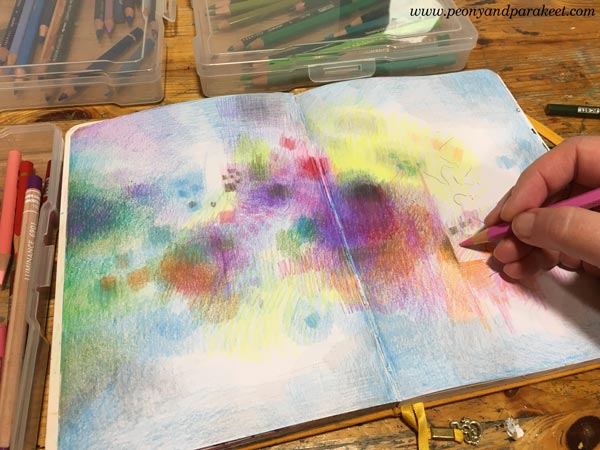
I have a small colored pencil journal where it’s easy to make a spread now and then.

This was a quick and fun little project.
Choosing Paper with Colors
The smoothness of the paper affects the coloring experience. Single strokes are better visible on smooth paper.

My colored pencil journal has very smooth paper, and I find it less effortless to color than a rougher one.

But when I want the colors to shine more and achieve a little blurrier and thus a softer result, the paper is better when it has some tooth.

I currently have a pad of Fabriano Accademia drawing paper and it’s very nice with colored pencils.

I keep my pencils organized by color. All brands are mixed in one box. Some are watercolor pencils, some are regular, and all of them are in the same mix.
Just Start! – Two Tips
Bring the pencils to a place where you can see them often. And then …”Just start!”
Sometimes it’s easier said than done. When getting started feels like a chore, I have two tips for you.
First, let the color do the talking. Pick a pencil and examine it’s tone. Color lightly first, and then bring in more layers. Every color has a spirit. Connect with it like it’s your pet or an angel. You don’t need to rationalize why you feel drawn to this or that color. Find the pencil that resonates the best with your current self.
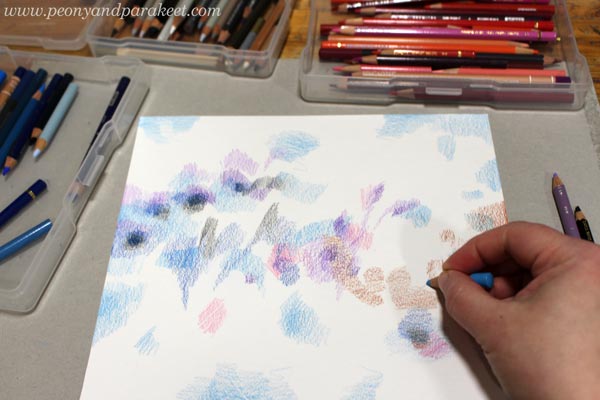
Second, give the color at least two other colors as friends. Often one color is very little, but when it’s side by side with two other colors, art will appear. A shape that has only one color is flat but with two other colors, it becomes much more lively.
Colored Pencils Say This All The Time
I know many colored pencils complain that they always have to create something figurative and realistic. They envy paints who can roam freely on paper and how people only smile at their tricks. Colored pencils are too often squeezed tightly and pressed hard against paper at the very beginning. They have to follow strict discipline and are under pressure to produce something that looks real. And when they try to do exactly as they are told, the result is stiff. “Nothing like what can be achieved with paints,” their owners say which makes the pencils sad. If they could choose they would be coloring without limits.
I believe in free education when it comes to colored pencils: “Make what you want and enjoy!” I often say to them. “Imagine that you are something more than just pencils!”
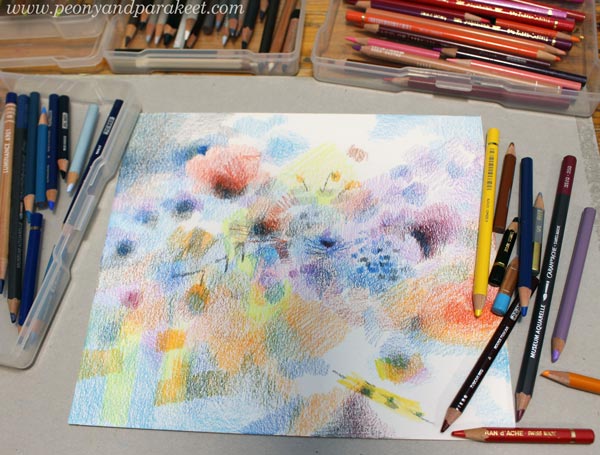
My pencils jump out of their boxes and do all kinds of silly marks. They are like paints.
Without Limits – Imagine You Are More!
In art, it is terribly important that we imagine to be more than what we are. Be more skillful, more innovative, more unique, and more important. Then, at that very moment, the pencils, life, and fantasy cannot be separated. The colors speak inside us and the art steps in.

Love of Coloring Without Limits
When I was a child, colored pencils often kept me company. They still bring me joy and I want to keep staying their advocate.

Get 20 % OFF from the classes Intuitive Coloring and Fun Botanicum!
The sale ends on Sunday, May 5, 2024, at midnight PDT.
12 Spring Art Ideas from Over the Years
This week, I share spring-themed art from the past 10 years and give ideas for creating spring art.
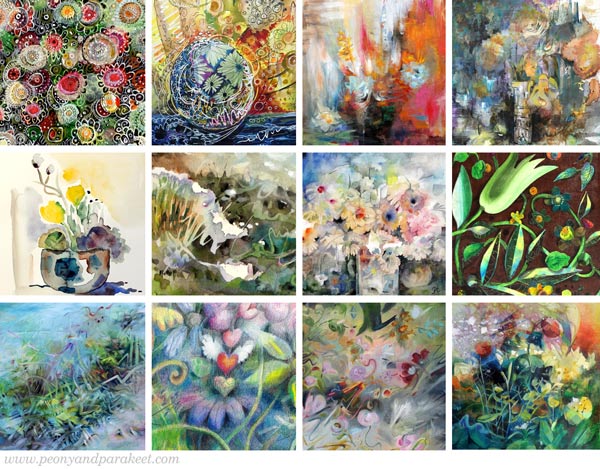
There’s a variety of ideas and I hope everyone can find some that inspire to get creating!
#1 – For Beginners and Dull Moments
Doodle spring flowers with the mindset “more is more”!
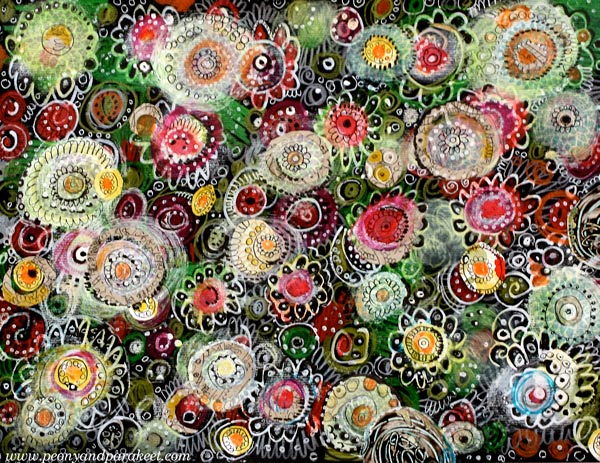
See the blog post: Subconscious Art
Course recommendation: Collageland
#2 – For Self-Explorers
Express your spring energy by following this step-by-step exercise: Bursting Circle
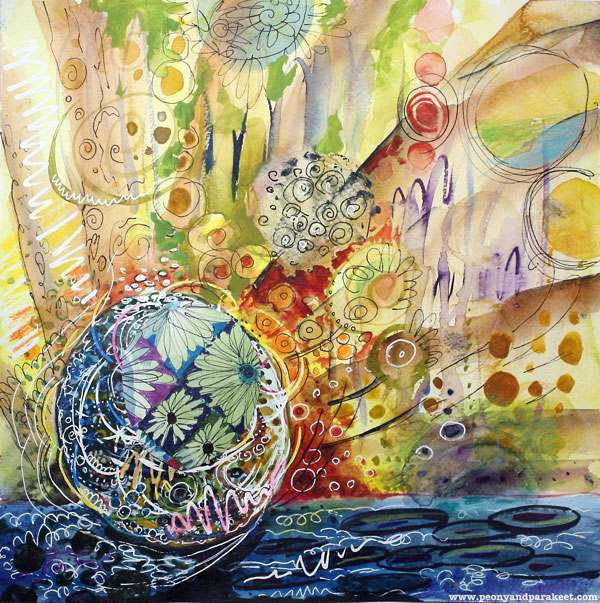
See the blog post: Bursting Circle
Course recommendation: Inspirational Drawing
#3 – For Free Spirits
Splash color and let everything grow from there!
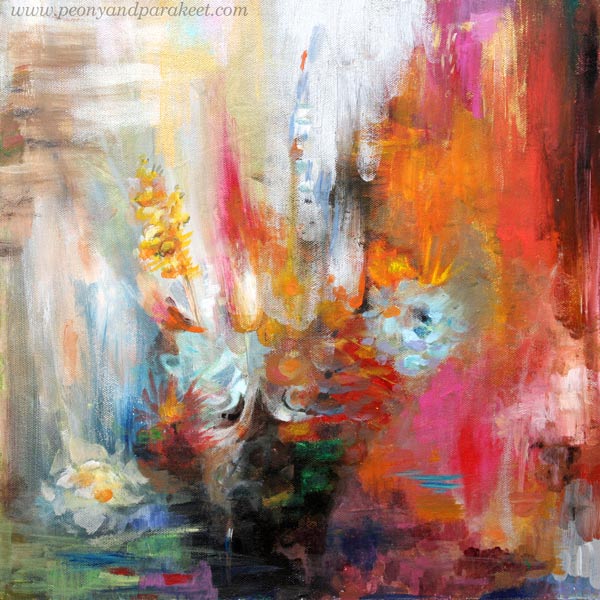
See the blog post: Art is Freedom
#4 – For Those Who Want to be Freer
When you want to be freer, the art of seeing is as important as the art of creating.
See the video of making “March Still Life”: Painting in Liberated Style
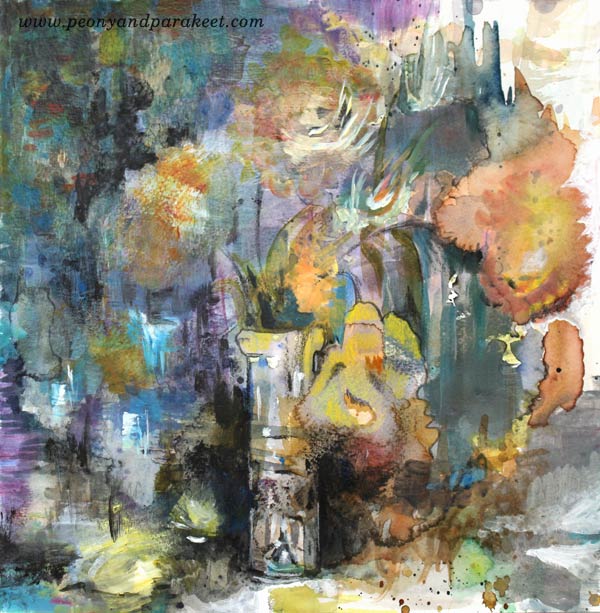
See the blog post: Painting in Liberated Style
Course recommendations: Liberated Artist Revisited and Freely Grown
#5 – For Minimalists
Pick a small piece of watercolor paper, moisten your watercolor pans, and let water do the trick.
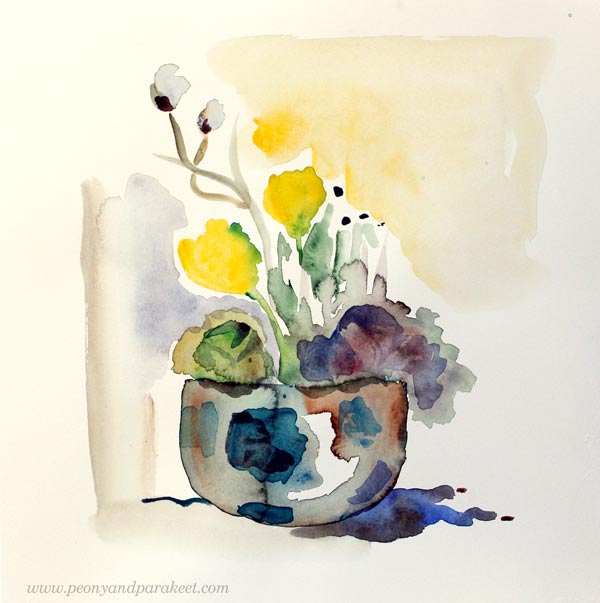
See the blog post: Easter Still Lifes in Watercolor – Video Included!
#6 – For Travelers
Paint a spring panorama. More examples: Watercolor Panoramas to Express Travel Memories
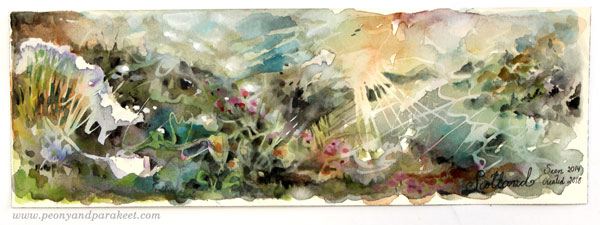
See the blog post: Watercolor panoramas to Express Travel Memories
Course recommendation: Watercolor Journey
#7 – For Beautiful Mess-Makers
Beautify the mess by adjusting the details: paint frilly edges and draw fine lines!
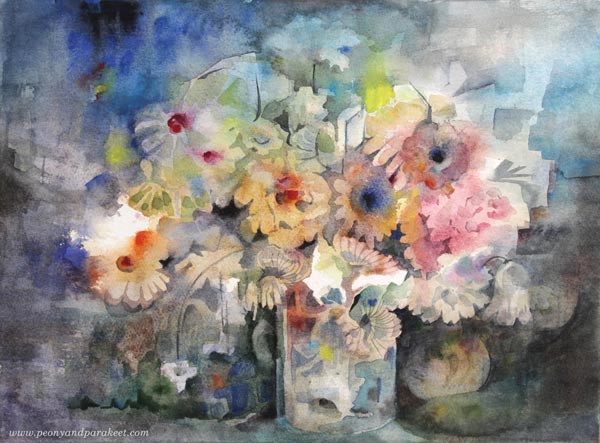
See the blog post: Freely Born Watercolor Florals
Course recommendations: Floral Fantasies and Freely Grown
#8 – For Journalers
Decorate a journal cover with your original art! See more instructions in this blog post: Painted Paper Collage
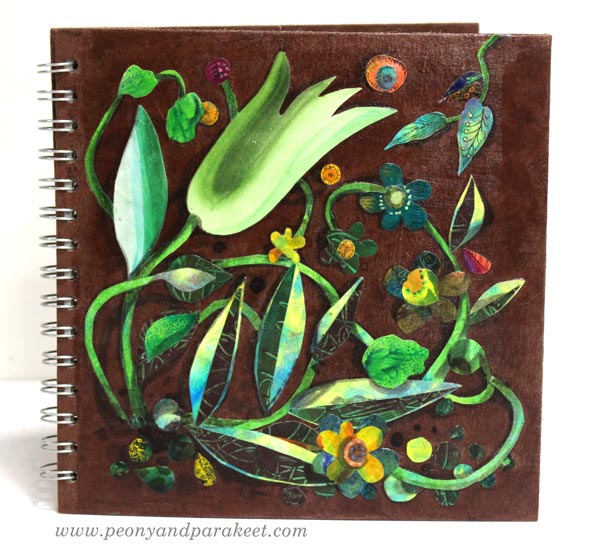
See the blog post: Painted Paper Collage – 6 Tips for Intricate and Fun Art
Course recommendations: Collageland and Decodashery
#9 – For Bird Watchers
Take this challenge to move from illustration to fine art:
Step out of your comfort zone and think about a bird shape as a canvas for expressing its surroundings.
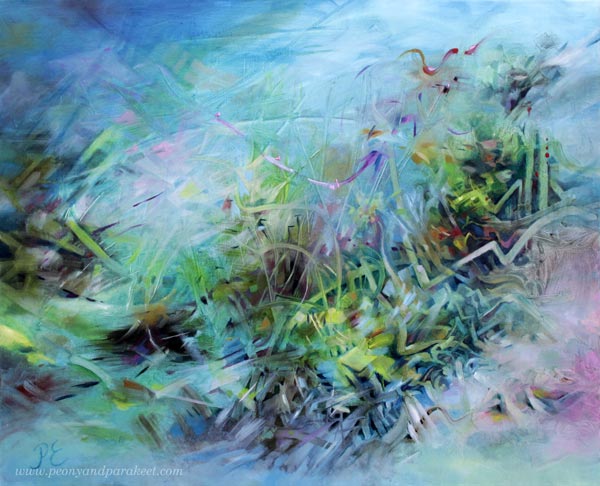
See the blog post: Pros and Cons of Becoming an Artist
Course recommendation: Floral Freedom
#10 – For Art Lovers Who Procrastinate
Reduce watching those photo-realistic colored pencil videos and start coloring freely. One heart shape can lead to many and start your flight to the world of imagination!
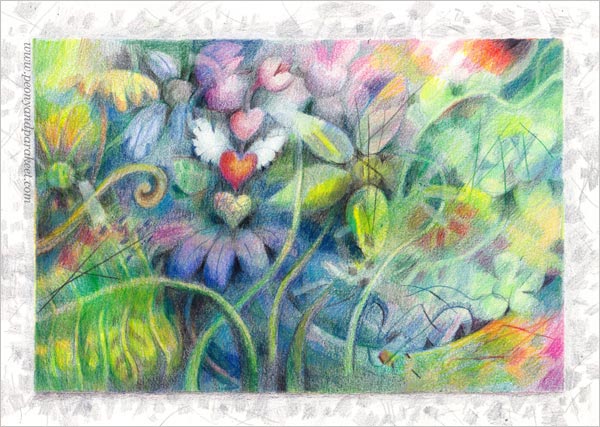
See the blog post: 5 Reasons Why I Love Colored Pencils
Course recommendations: Intuitive Coloring and Fun Botanicum
#11 – For Wannabe Fantasy Artists
Find the story first, then its surroundings! A character is not only described by his face.
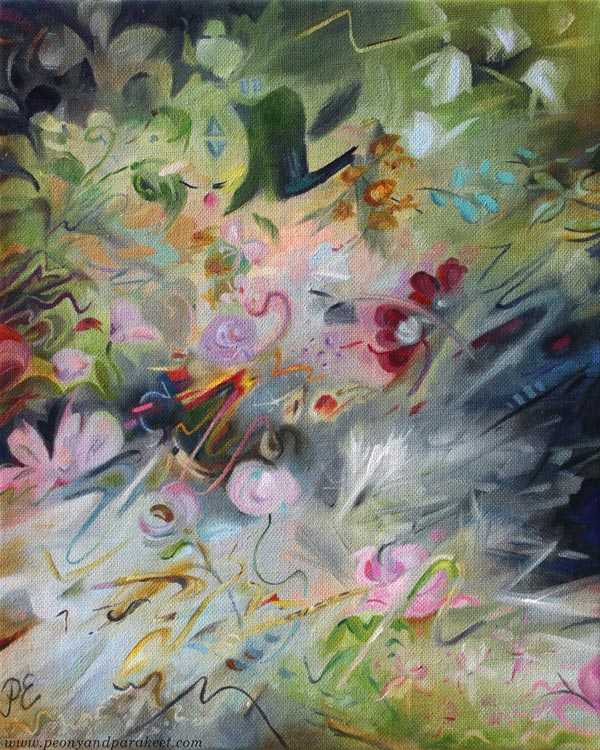
See the blog post: Wonderland Art – Inspiration from Alice in Wonderland
Course recommendations: Magical Forest and Magical Inkdom
#12 For Artists at Heart
Our creativity has winter and spring too. We need each other to keep the inspiration going – to turn the winter into spring.
A challenge for you: How can you make a new start – create a new spring for your art?
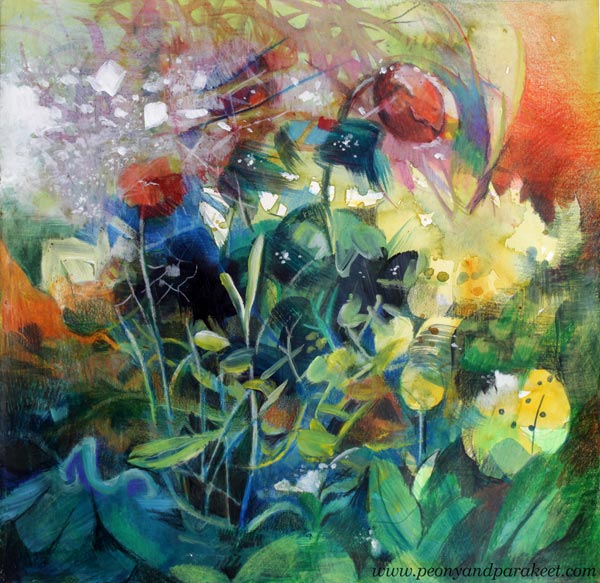
See the blog post: New Beginnings in Art-Making
Course recommendations: Liberated Artist Revisited
Bonus Idea #1: Spring Art Display
Gather your art on a side table for display! Make a collection of all kinds of pieces – even the smallest drawings and collage pieces can look fun this way.
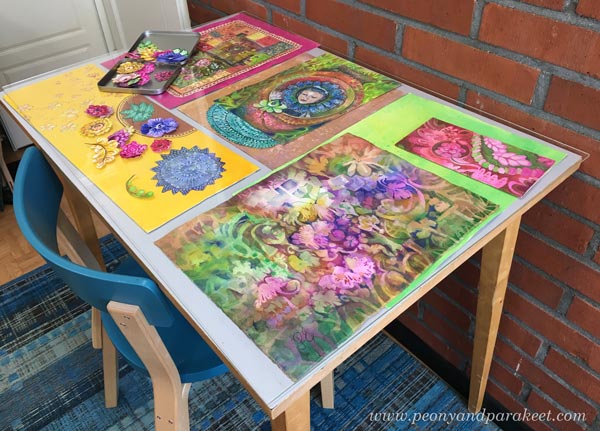
I have a plastic plate that is the same size as my table.
It protects my art, and it also protects the tabletop when painting in watercolor.
Bonus Idea #2: Listen to This!
I also have a music recommendation: “Kevät”
Kevät is spring in Finnish and the song was presented by a Finnish girl band Tavaramarkkinat in 1985. Here’s an English translation of the lyrics. The tone of the song is melancholic. This kind of controversy between melancholy and joy is one of the most inspiring things in spring, I think!
P.S. PostScript for Spring Art Ideas
We still have a lot of snow in Finland, and I miss spring so much! In these spring art ideas, I wanted to combine my yearning for spring and the celebration of being a full-time artist for ten years. The actual anniversary is in September, but I want to celebrate this life span the whole year of 2024.
One part of the celebration has been making the course Liberated Artist Revisited where I invite you to paint with me – to follow directions from Paivi many years ago, and then create more with the current Paivi. At the same time, you can ponder, how your art-making has changed and will change.
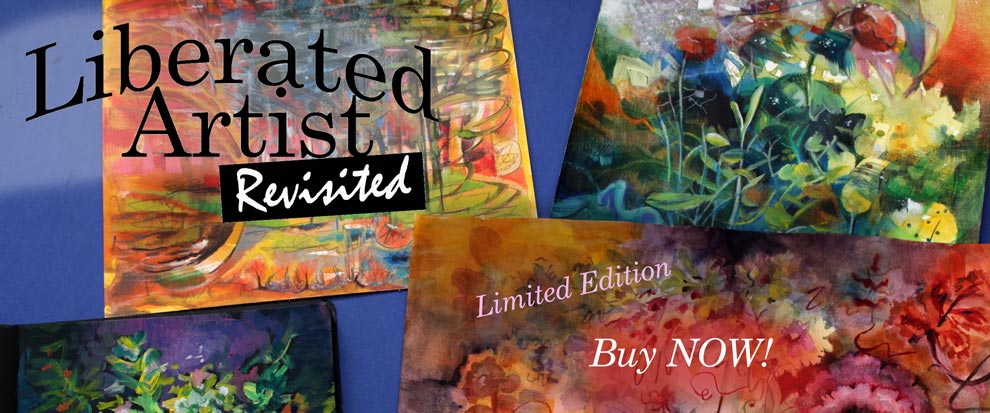
Because of the 10-year celebration and the nature of personal stories, Liberated Artist Revisited is a limited edition – only available for purchase until the end of March 2024! >> Buy Now!
5 Tips for Quick Abstract Flowers
This week, we paint quick abstract flowers freely without any references.
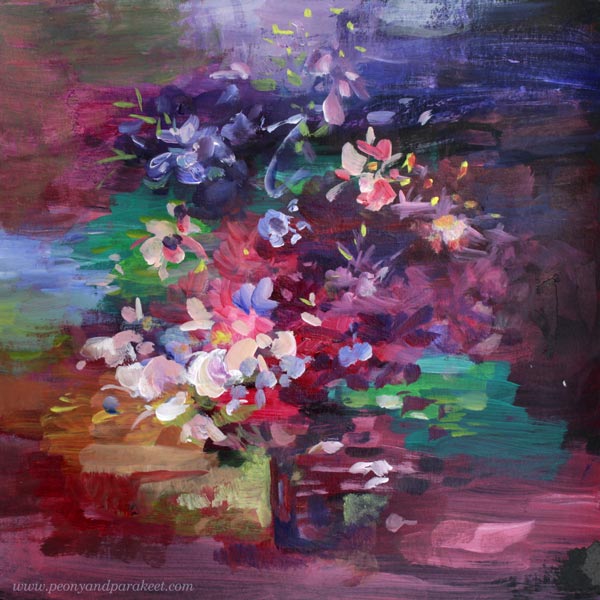
I have a black Dylusions Creative Journal and make small paintings there occasionally. It is especially good when there’s still paint left on the palette at the end of the painting session. I think it makes sense to use all the paint, and not throw the leftovers in the trash.
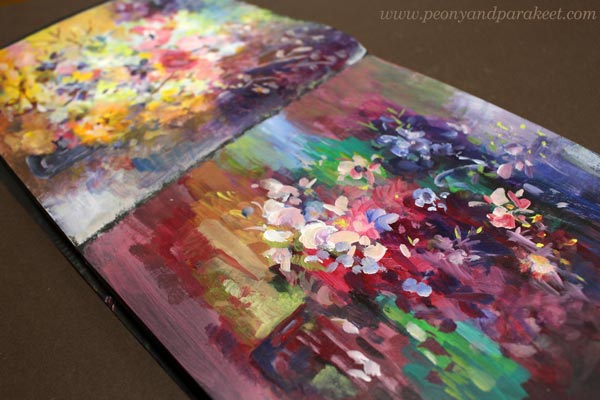
I don’t use any gesso but paint directly on the page.
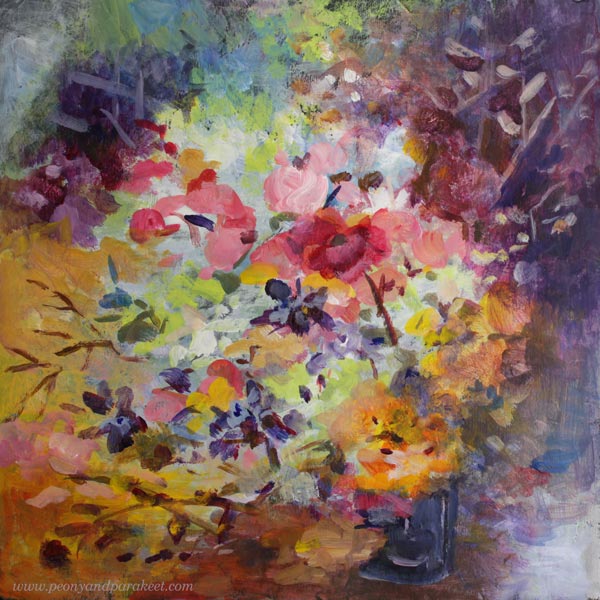
When I painted pieces for the course Liberated Artist Revisited, I noticed that there had been a long break in acrylic painting and some of the tubes had started to harden.
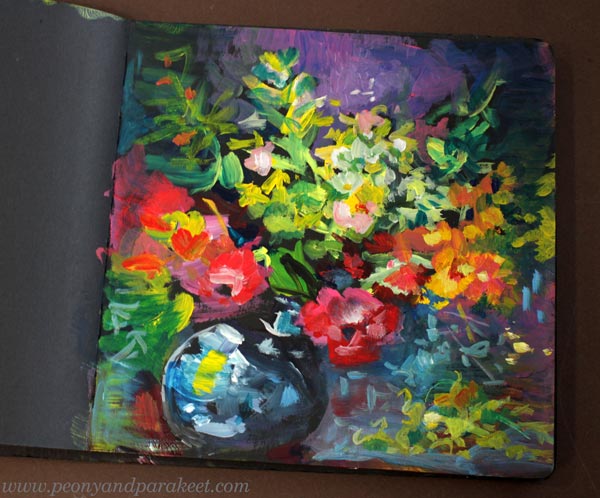
It motivates me to paint in the black art journal again because I don’t want those paints to go to waste. And sometimes it’s nice to paint something small quickly and see what comes out most effortlessly.
Quick Abstract Flowers – Five Tips!
I like painting abstract flowers, and thick paints are very suitable for abstract flower paintings. Here are my five tips for painting flowers quickly.
1) Start from the Old Mess
The fastest way is to start from an old painting.
I have a lot of pages in my journal where I’ve hastily painted shapes with leftover paints.
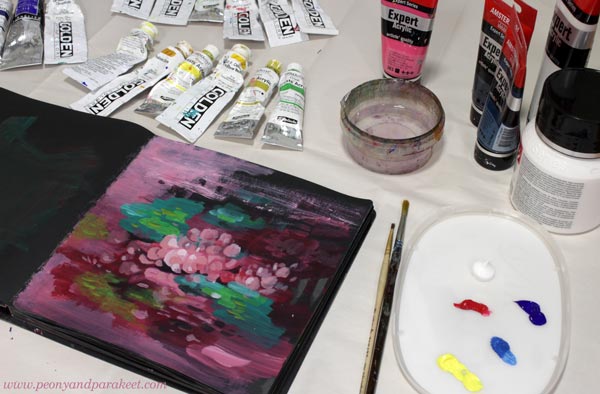
Continuing the beautiful mess feels much more effortless than starting a new one from the beginning.
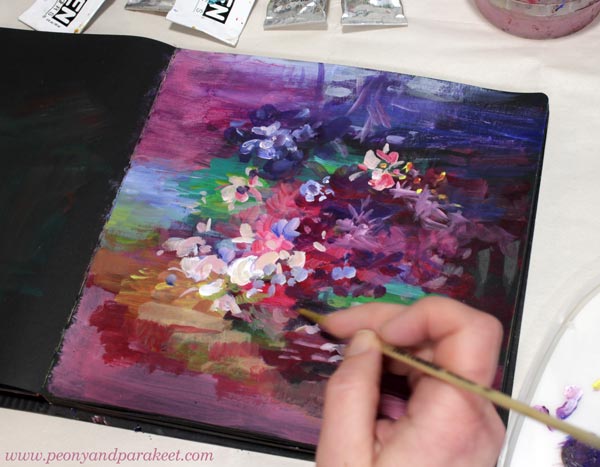
For example, here’s one page that still waits its turn to become a finished painting.
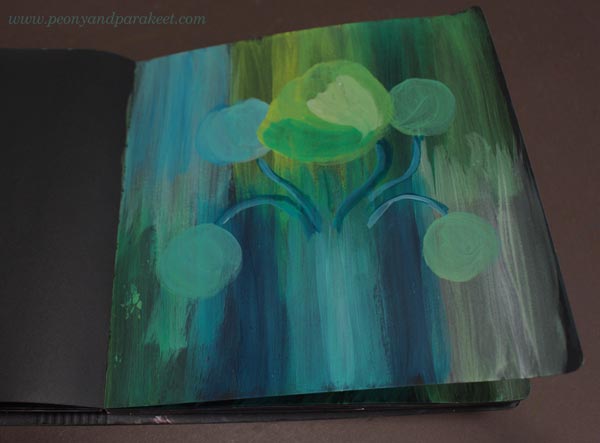
Most of my beginning messes are much more messy though!
2) Dark-Bright-Light
Include all three degrees of darkness in one painting.
Make color mixes and compare them in terms of darkness. By including all three – dark, bright, and light – you can achieve depth and atmosphere.
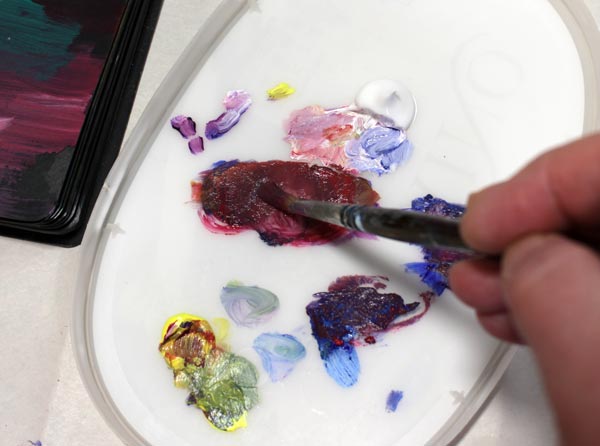
Make clear larger areas so that you can point to different places in the background and say, there is dark, there is bright, and there is light.
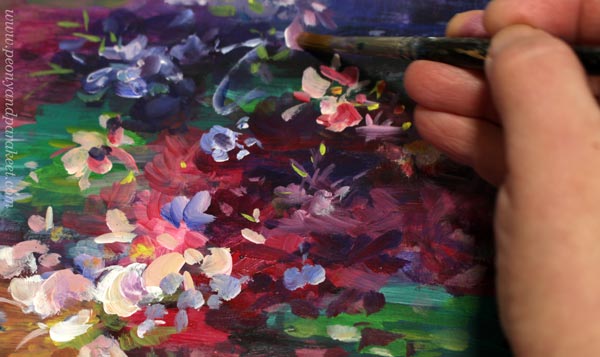
Flowers can have all three – dark, bright, and light colors.
3) Forget the Real Flowers!
Don’t think too much about the real flowers.
Don’t think about what a rose looks like or what flowers you want in your painting. All that stiffens your expression.
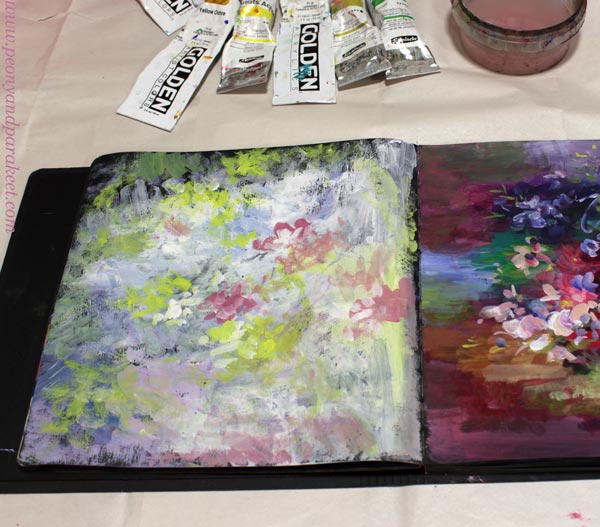
Focus on the colors and let the flowers form from the brushstrokes.
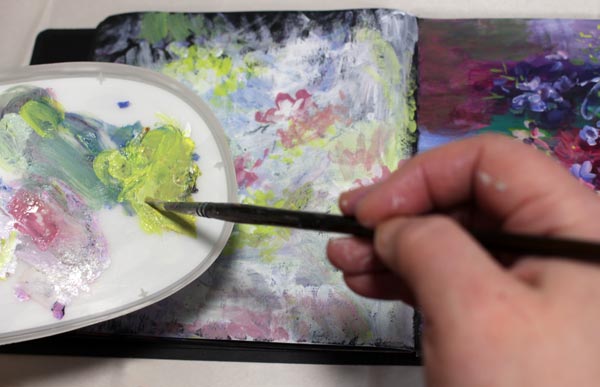
After all, a flower is just a few colorful strokes and a line for the stem.
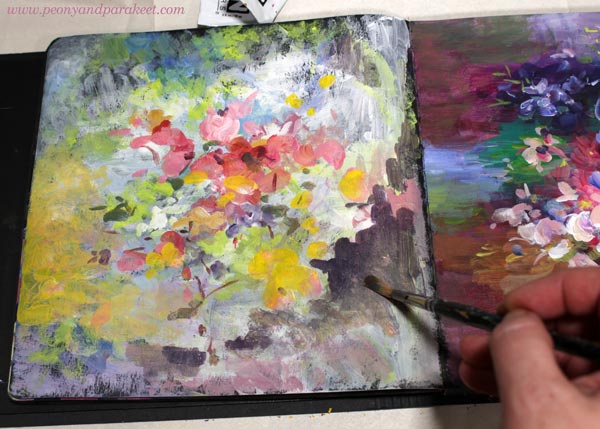
Use your imagination when you look at your work in progress!
4) Leave Room for Spirit
Not everything needs to be defined or look like a flower.
Flowers are concrete matter, so let the colors express the spirit!
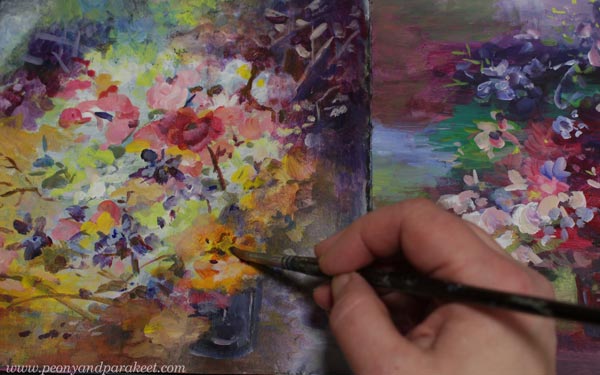
If you want to be extra quick, sharpen just one flower near the center and leave the others more abstract and vague.
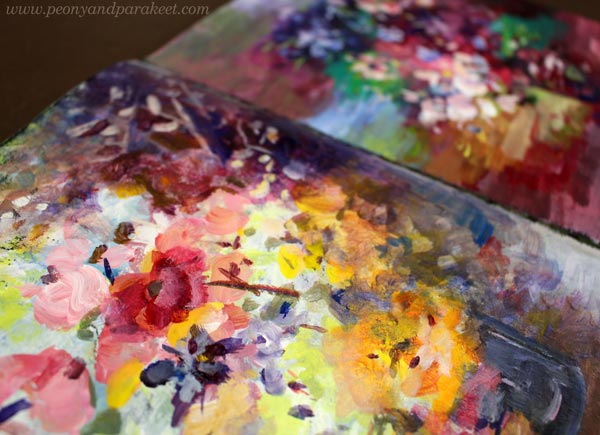
5) No Forced Feelings
Open yourself up to an emotional experience.
The speed of the painting depends highly on how soon you get an emotional connection with yourself and what you are doing. Let even the darkest thoughts come. For creativity, everything genuine is equally good.
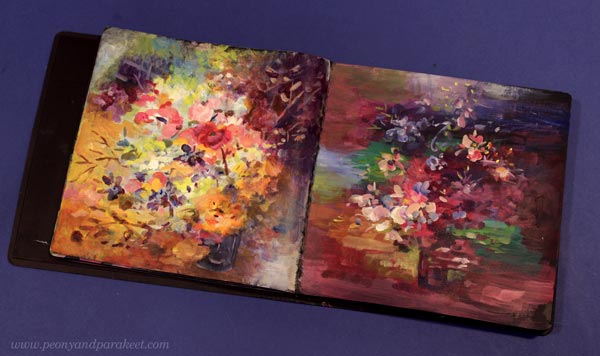
The beauty of making art is that imagination creates abundance and eternal life from almost nothing – from the leftover paint and leftover energy. And the more often you create, the more you get out of it!
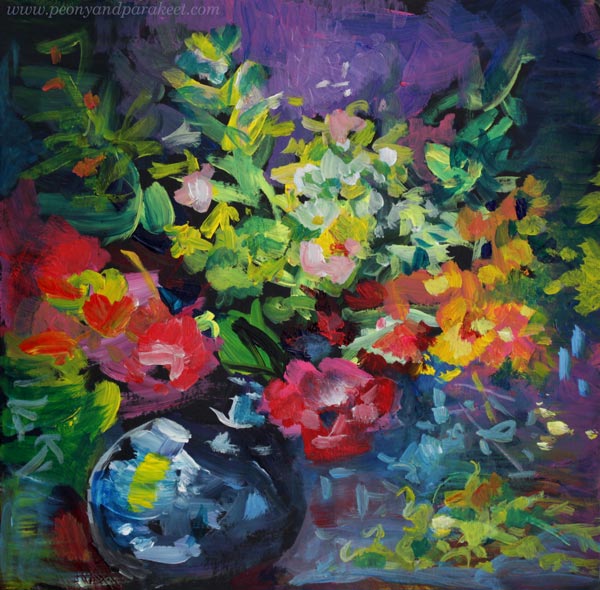
Liberated Artist Revisited – Buy Now!
In Liberated Artist Revisited, we time-travel to meet the teacher – Paivi from 2015, and create new art with her.
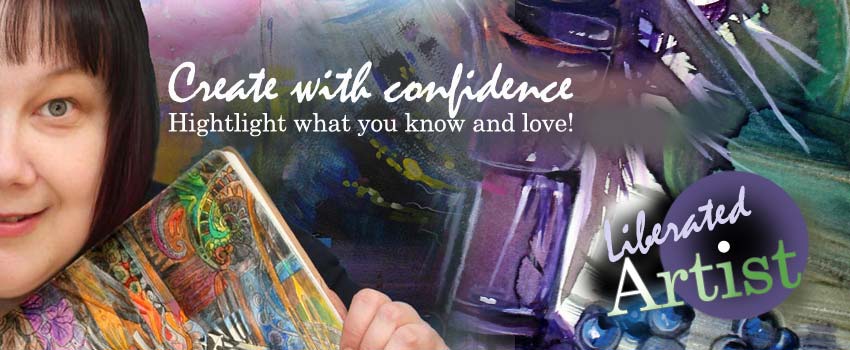
This course is both for the left and right brain. The young Paivi gives systematic instructions while the older Paivi enjoys her freedom and ponders about art-making and life in general.
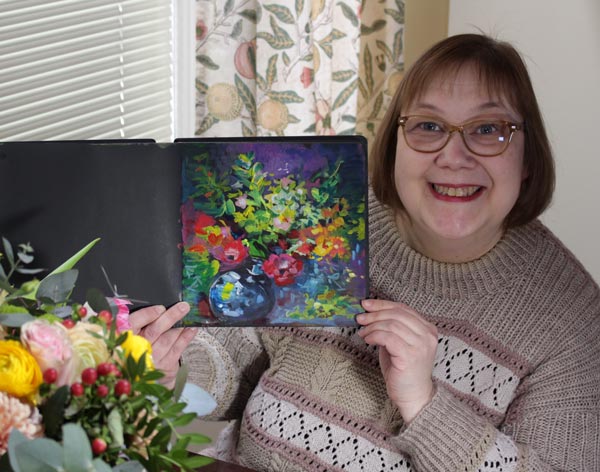
Liberated Artist Revisited is a limited edition – only available for purchase until the end of March 2024! >> Buy Now!
Inspiring Art Journals
This week is dedicated to inspiring art journals that hopefully make you start creating right away.
Towards the end of last year, I started to really miss drawing. When I want to come up with ideas, I need a pen and paper! Or maybe I should say that I need my art journals because that’s where the ideas stay in good order.
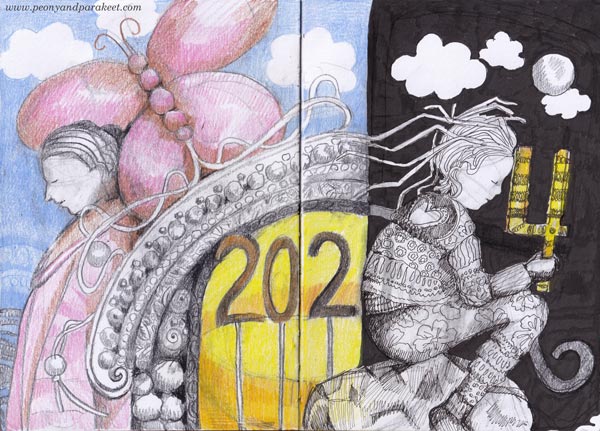
I made this spread in my colored pencil journal. 2023 is an old romantic woman that is going away and a young girl who is ready for adventure will take her place.
There are only a few pages after the previous year’s spread.

I hope to make more pages in this colored pencil journal this year.
Inspiring Art Journals
This week, I picked up random art journal books and browsed them. I especially love the one in the upper left corner with the black and white drawings the most.
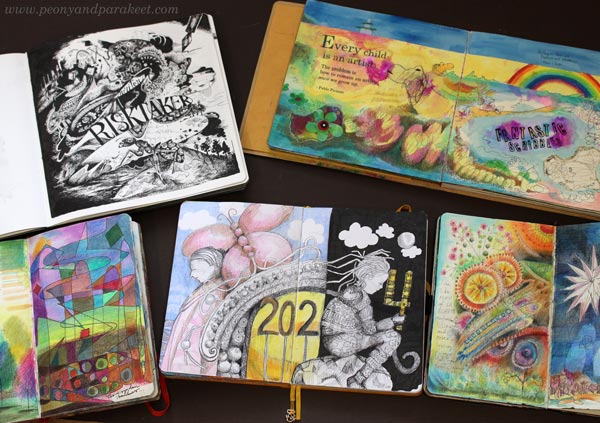
The drawings have no color but they are all full of ideas that still inspire me.
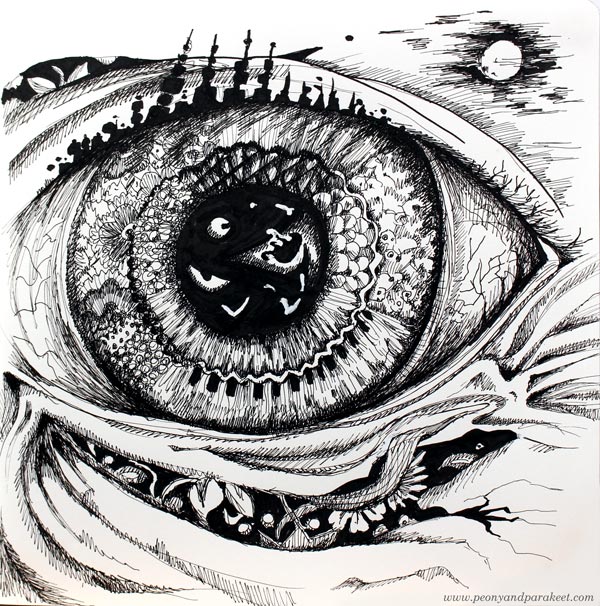
I now want to add ink drawings to my colored pencil journal as well.
Tiny Pages
Last year I bought a very small art journal. This is a pretty cute page!
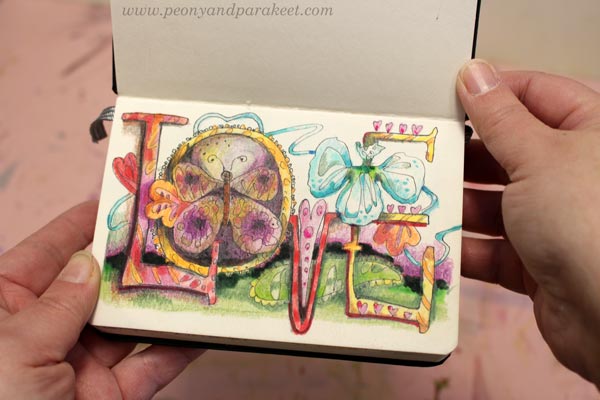
All the reds and pinks looked very nice together.
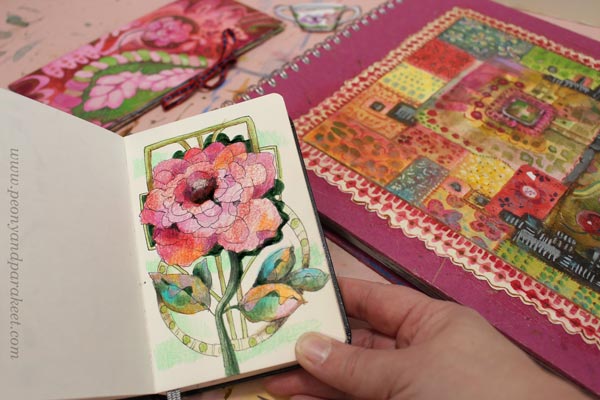
Years go by and my skills grow, but even the clumsiest covers still seem to fit with the new creations.
Doodler’s Resort
While browsing the journals, I found a spread with a transparent film in the middle. I had printed doodles on it and I still quite like the effect. This idea is from 2020, when the world stopped and I couldn’t do anything but mindless doodling.
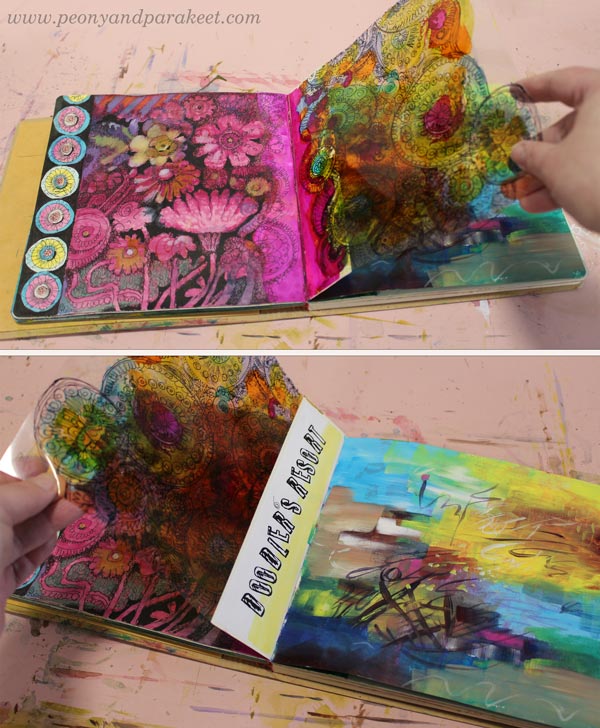
This art journal also has a lovely inside cover.
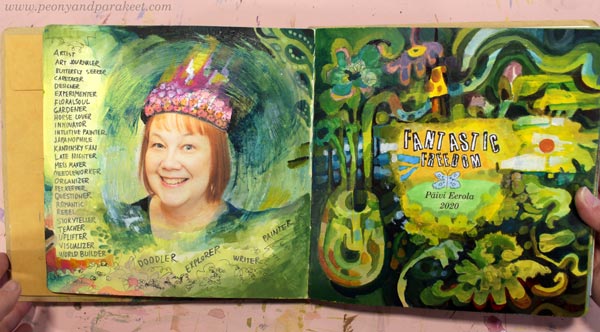
Divide the Content!
I don’t understand why it took so long before I realized that I could add annual pages, inside covers, chapters, and other pages telling about the content of the book in art journals.
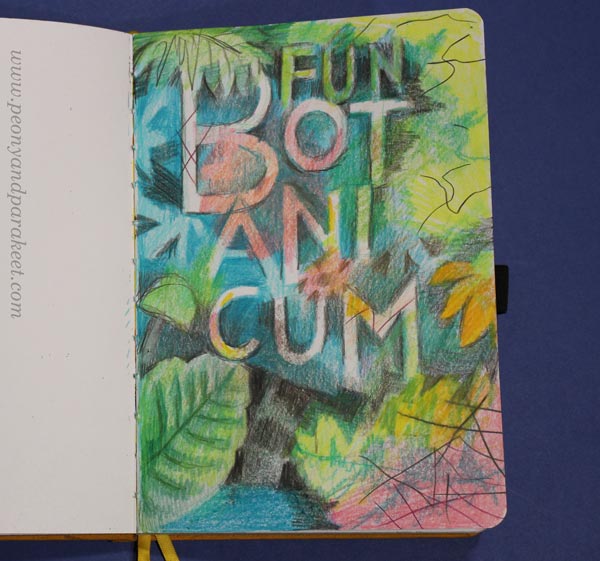
Nowadays, I have a course called Fun Botanicum, where you make a chapter cover, themed pages, and an end page in the middle of an art journal.
Inspiring Art Journals Tell About Time
It was fun to look at old art journals and wonder how these are connected to everything that is going on now.
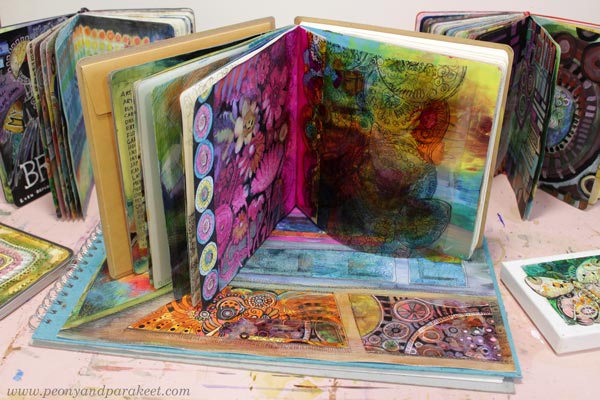
Time is a mysterious place. It is like an illuminated palace that blinds us. We can only walk away from it to the darkness. But as long as we are alive, we can start the adventure and get creative. “It takes a long time to become young,” said Pablo Picasso.
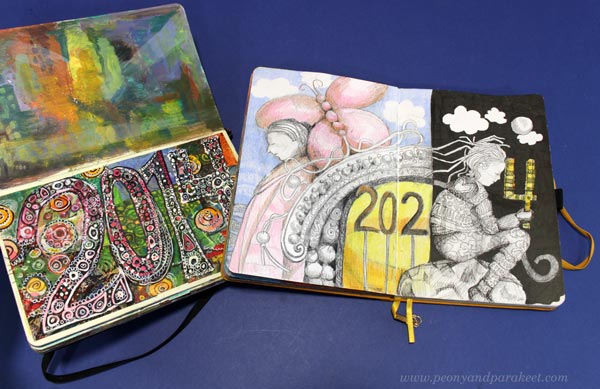
In my opinion, only by drawing can we know what we really think. The more you draw, the more your skills grow, and the more you will find out!
Do you agree?